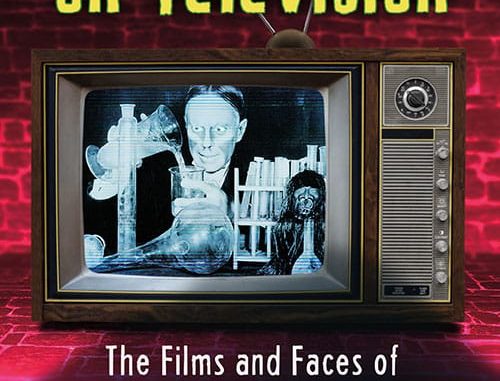
Review Fix chats with “Hosted Horror on Television: The Films and Faces of Shock Theater, Creature Features and Chiller Theater†author, Bruce Markusen, who discusses the book and the horror flick that inspired it, as well as his next project.
About the Book:
In October 1957, Screen Gems made numerous horror movies available to local television stations around the country as part of a package of films called Shock Theater. These movies became a huge sensation with TV viewers, as did the horror hosts who introduced the films and offered insight—often humorous—into the plots, the actors, and the directors. This history of hosted horror walks readers through the best TV horror films, beginning with the 1930s black-and-white classics from Universal Studios and ending with the grislier color films of the early 1970s. It also covers and explores the horror hosts who presented them, some of whom faded into obscurity while others became iconic within the genre.
About the Author:
Bruce Markusen has written eight prior books and oversees the Facebook page The Ghostly Gallery. He lives in Cooperstown, New York.
Review Fix: What inspired this book?
Bruce Markusen: I was motivated to write about how I first became interested in horror films in the early 1970s. For me, it started with the young adult anthology books that carried Alfred Hitchcock’s name – Ghostly Gallery and Haunted Houseful. I loved those books and the great illustrations that came with them. That got me interested in watching horror films, especially the late-night offering that were made available through “Chiller Theater,†which aired on WPIX out of New York City on Fridays and Saturdays. Chiller Theater no longer had a host at that time, but it did have the six-fingered hand coming out of the swamp! I loved those movies, which were often films from the fifties and sixties. I was obsessed in staying up late to watch those films.
So that was the initial reason for me to want to write about the books. Naturally, it followed that I would write about the broad range of good films that came out from the early 1930s through the early 1970s, because those represented the era of films featured on late-night shows like “Chiller Theater†and “Creature Features.†And ultimately, I wanted to provide a guide to younger fans who might enjoy vintage horror, by giving them an in-depth summary of some of the best films from that era – films that hopefully the younger generations will find some pleasure in watching.
Review Fix: What was your research process like?
Markusen: I began with my own personal memories and then began to fact-check them, because it’s so easy for us not to remember details from 50 years ago. I tried to use as my resources as I could find, including the Internet (where IMDB and sites like Bloody Disgusting were especially helpful). Also the Internet is a great resource for vintage newspaper articles featuring information about many of the horror hosts, some of whom would otherwise be forgotten by time. A number of historical books were also helpful, including volumes on Universal Studios, biographies of Karloff, Lugosi, and Lon Chaney, Jr., and overviews of horror film history from the first half of the 20th Century.
I also spend a good deal of time attending horror conventions like Scare-A-Con and Monster Bash, where I was able to interview writers and historians and directors who have a greater depth of knowledge than I do. No one turned me down; every author, actor and director was willing to talk to me about films from these earlier eras of horror. And almost every one of them was enthusiastic about helping out.
Once all of that done, I did my best to fact-check everything and then spent a lot of time compiling an index, which will hopefully make this book a good reference tool, as well as a fun narrative.
Review Fix: What’s your favorite part of the book?
Markusen: I particularly like the parts of the book where I deal with the classics like Dracula, Frankenstein, and The Wolf Man, and also the later sections where I discuss many of the intriguing films of the 1960s and early seventies. Not only are those latter films the ones that I grew up with, but they also come from a time when the number of horror films exploded, and the content of the films featured more disturbing imagery and themes. And a little more violence, too.
Review Fix: What other important concepts does your book explore?
Markusen: The book has a chapter on Vampira and Zacherley, the two great pioneers among the horror hosts, and then a later chapter that looks at some of the local hosts who became popular in certain geographic regions, like Bob Wilkins in the Bay Area and Ernie Anderson in Cleveland. Imagine the idea of a grown adult dressing up in a wacky costume and then making smart-aleck remarks about the movie showing that night! Only in the world of horror.
The last chapter of the book then examines the current state of horror – and I happen to think we’re enjoying a horror renaissance now – and how conditions are right for a return to glory for the horror host. Sure, we have Joe Bob Briggs and Svengoolie, but I believe there’s potential for more horror hosts to have a national impact, too. We’re in an exciting time within the genre.
Review Fix: Any challenges?
vSure. The biggest was this: I’ve never written a book like this before. I did write a vampire novel, Haunted House of the Vampire, but most of my books have been about baseball – a completely different subject, to say the least. I thought I knew a lot about horror going into this project, but quickly realized I had so much more to learn. I couldn’t have done this without help from so many great writers. Two in particular, Frank Dello Stritto and Greg Mank, were incredibly helpful. Just top-notch guys. They gave me advice, helped me find photographs, and just taught me so much more about horror history. David Skal, another esteemed writer, was also a godsend. He did a long sitdown interview with me at Scare-A-Con. His comments throughout help enliven the book. And then there was director Harrison Smith, who knows so much about horror history, and actress Genoveva Rossi, who is also a film historian and writer. They all helped me overcome some major challenges.
Review Fix: What makes horror like this unique and special?
Markusen: These films cover a wide range of time – from the 1930s to the 1970s – and there are many differences among the films, but they’re all great choices to watch on a late Friday or Saturday night. I mean, you can’t go wrong with Frankenstein from 1931, The Wolf Man from 1943, The Body Snatcher from the 1950s, and Rosemary’s Baby from 1968. They’re all good. While filmmaking techniques change and have become more sophisticated in the last 30 years, many of these old films hold up. They are still very watchable and very entertaining.
Review Fix: What do you think its legacy is?
Markusen: McFarland specializes in selling to libraries, so I’m confident the book will have a place on shelves for years to come, both to film diehards and more casual fans. I also hope that younger generations of fans will discover these old movies, many of which are gems. So often I mention the name of a Karloff or a Lugosi or a Vincent Price to a person in their twenties, and they respond by saying, “Who?†I hope this book will help change that, even a little bit.
Review Fix: What did you learn that you weren’t expecting?
Markusen: Two things. First, I learned that actors like Karloff and Lugosi were not just fine actors from the genre, but both deserve to be recognized as great actors—period. They were both capable of doing drama, thrillers, and comedy –and in Lugosi’s case, he did do quite a bit of comedy toward the end of his career. Luckily, we horror fans were able to enjoy them in our genre. We’re able to claim Karloff, Lugosi, and Lon Chaney as our own.
Second, I discovered that there are lots and lots of bad horror films from those earlier years, some of which are unintentionally funny, and others which look like they were slapped together within a matter of days. But there are also so many good horror films from that time period (1931 to 1975). I included roughly 150, and I’m sure that there were other good ones that I missed. That averages out to a little more than three really good horror films a year. And that’s pretty impressive, especially given that horror films really did not start to come out in high volume until the 1960s.
Review Fix: How do you want the book to be remembered?
Markusen: I’d like the book to be remembered as a personal memoir, but also as one in which I objectively tried to include the best horror films. I didn’t want to highlight the bad movies; I wanted to put the spotlight on the good-to-great films that older fans can continue to watch, and that younger fans might be willing to try out for the first time.
Review Fix: Why should a horror fan read this?
Markusen: I’d like to think the story of hosted horror on TV is an intriguing one, and I hope that the writing is good enough to keep people compelled in wanting to keep reading. As a horror fan, it’s the kind of book that I would like to read, and I’m hoping that others share that opinion.
Review Fix: What’s next?
Markusen: My next project is a baseball book that I’m currently working on, and then after that, I need to put some finishing touches on a book about the ghost stories of Cooperstown, NY, where I offer ghost tours. And then perhaps I’ll try to sit down and write another book about horror films or horror popular culture. That would be fun.


Leave a Reply